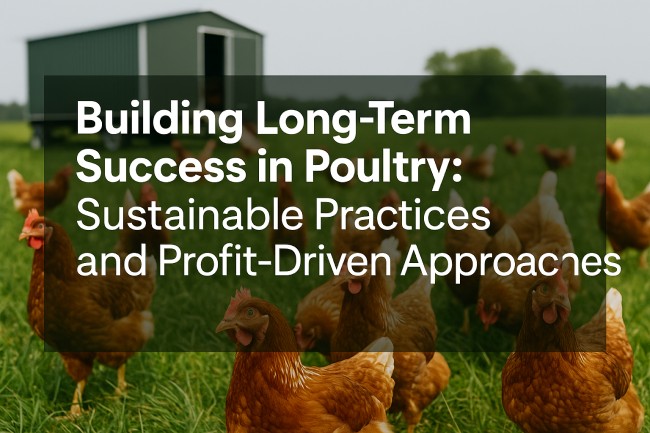Building Long-Term Success in Poultry: Sustainable Practices and Profit-Driven Approaches

The poultry industry continues to be one of the most profitable segments in global agriculture. With demand for chicken and eggs rising steadily, poultry farming offers plenty of opportunity—but also a fair share of challenges. Success in this space isn’t just about raising birds; it’s about implementing smart, sustainable practices that lead to strong financial returns year after year.
Whether you’re scaling up an existing operation or entering the industry for the first time, long-term success depends on three major areas: efficient production, sustainability, and adaptability. Let’s break down how to put these pillars into practice.
Focus on Sustainable Production from Day One
Raising poultry at scale requires resources—feed, water, energy, and land. But high-output systems can take a toll on the environment if not managed properly. That’s why sustainability must be baked into your production model from the beginning.
Start with your feed strategy. Opt for locally sourced ingredients when possible to reduce transportation emissions and cost volatility. Some farmers also experiment with alternative feed inputs like insect protein or food waste, depending on regulations and market preferences.
Water usage is another area where improvements go a long way. Installing water-efficient delivery systems and regularly monitoring for leaks helps conserve this critical resource. Waste management, including proper litter handling and composting, not only reduces runoff and odors but can also generate income when managed well.
Sustainability isn’t just about doing good—it’s about lowering your operating costs over time and preserving resources that your business depends on. Plus, today’s consumers increasingly expect environmentally responsible farming practices. Meeting those expectations can create a marketing edge.
Invest in Technology that Streamlines Operations
Modern poultry farms look very different from what they did a decade ago. Automation, smart monitoring systems, and mobile units are changing the way farmers manage their flocks. These innovations reduce labor costs and improve overall efficiency.
Temperature and humidity sensors in chicken houses help maintain the ideal environment for bird growth. Feed dispensers can be calibrated to reduce waste and ensure birds receive consistent nutrition. RFID tags allow you to track individual bird health and weight in real-time, improving inventory management.
One standout tool is the commercial mobile chicken coop. These mobile systems allow farmers to rotate flocks across pastures, promoting natural fertilization and reducing disease risk. They’re ideal for operations focused on free-range or pasture-raised certifications and offer better soil health over time.
By embracing tech-driven tools, you’re not only boosting productivity—you’re building a resilient system that can adapt as markets, regulations, and consumer demands shift.
Prioritize Animal Health and Biosecurity
A single disease outbreak can devastate a poultry farm’s finances and reputation. That’s why biosecurity isn’t optional—it’s foundational.
Start by controlling access to your farm. Limit visitors, require clean clothing and footwear, and implement a designated disinfection zone. Vehicles and equipment should also be sanitized before entering.
Routine health checks and vaccinations help prevent common diseases like avian influenza and Newcastle disease. Isolate new birds before integrating them into your main flock to monitor for signs of illness. Maintain a close relationship with a trusted vet who can guide you through proper medication protocols and preventive measures.
Stress, overcrowding, and poor ventilation often lead to compromised immunity. Comfortable living conditions don’t just keep birds healthy—they support better growth rates, feed conversion, and overall performance.
Understand Market Trends and Consumer Behavior
Profit-driven approaches require more than just good farming—you also need to know what buyers want and where the market is heading.
Today’s consumers are interested in more than just price. Many care about how their food is produced. Labels like “antibiotic-free,” “pasture-raised,” and “organic” often command a premium. That said, it’s important to choose claims that are feasible for your operation to support both your values and your bottom line.
Staying informed about broader trends—such as increasing plant-based competition, changes in food service demand, or new export regulations—can help you pivot when necessary. Organizations like the USDA and FAO (Food and Agriculture Organization) regularly publish research and market data that help producers make informed decisions.
Also, don’t overlook branding and storytelling. Consumers like transparency. If you’re running a clean, ethically sound operation, don’t be afraid to show it off. Leverage social media, farmer’s markets, and local partnerships to build direct relationships with buyers.
Balance Profit with Purpose
The most successful poultry businesses balance economics with ethics. That doesn’t mean sacrificing profitability—it means building systems where doing the right thing also makes financial sense.
For example, instead of viewing waste as a problem, treat it as a potential resource. Poultry litter can become compost or even bioenergy. Leftover feed or broken eggshells may have secondary uses in pet food or fertilizer markets.
Similarly, fair treatment of workers leads to better retention and morale—factors that indirectly improve efficiency and reduce turnover-related expenses. Offering training and safety programs pays off in the long run.
Being mission-driven makes it easier to attract partnerships, customers, and even investors who are aligned with your values. In today’s landscape, that alignment matters more than ever.
Final Thoughts
There’s no one-size-fits-all formula for success in poultry farming. But a few principles remain constant: operate efficiently, protect your resources, adapt to change, and meet market demands. Those who invest in sustainable practices and think long-term are the ones best positioned to thrive.
Building a poultry operation with staying power takes time, planning, and a willingness to evolve. It’s not just about raising birds—it’s about raising your standards, your systems, and your bottom line.



